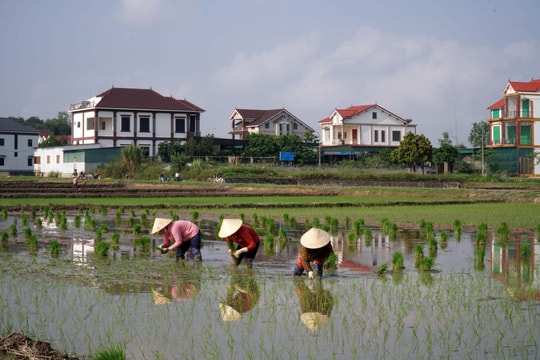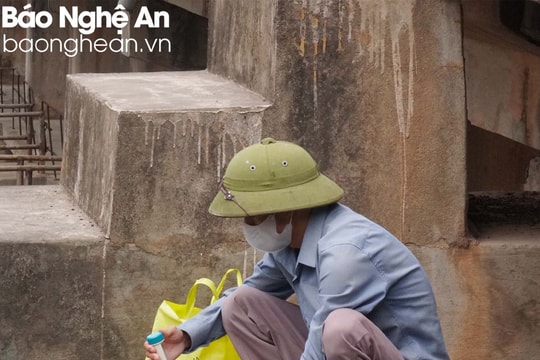By Confining the Mekong River, China Could Cause Global Instability
A series of hydroelectric dams built by China on the Mekong River have seriously altered the flow, possibly affecting world food security.
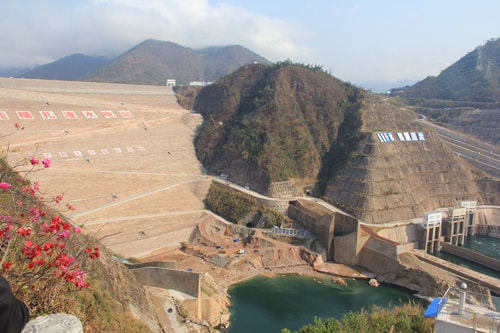 |
Noa Trat Dam Height 261.5 m, the largest hydroelectric dam in the upper Mekong River. Photo: Flickr |
When China's Xinhua news agency announced that the Nuozhadu Dam, the largest dam on the upper Mekong River, had started generating electricity from its first unit, the news was hardly reported by any newspapers in China or around the world.
Nuozhadu is one of six large hydroelectric dams that China has built on the Mekong River that flows through its territory. The country plans to build a series of seven dams on this river, and it is likely to cause rapid changes in water levels and other impacts on the downstream region, where tens of millions of people in four countries Vietnam, Cambodia, Laos and Thailand depend heavily on this river, according to the Washington Times.
“China’s hydropower dams on the Mekong River are built in remote areas and receive very little attention from the Western media,” said Milton Osborne, a Southeast Asia expert at the Lowy Institute, an international policy think tank in Sydney, Australia.
“But, like the hydropower dam projects being explored in Laos and Cambodia, what is happening in China will ultimately change the ability of Southeast Asia’s longest and most important river, which is vital to the livelihoods of 60 million people downstream, to produce rice and other products,” the expert stressed.
Though little noticed, the announcement of the Nuozhadu Dam’s operation is significant because it reflects Beijing’s view that the cascade of dams it is building on the river will not affect other countries downstream, given that only 13.5% of the Mekong’s water flows through China, according to Osborne.
However, experts have repeatedly rejected China’s claim. Mr. Osborne believes that the Mekong River’s water flowing through China plays a very important role in maintaining dry season flows for downstream countries, and can account for up to 40% of the river’s total flow.
“Every dam China builds creates a greater risk of depleting the river’s flow, especially since both the Xiaowan and Nuozhadu dams act as storage dams, restricting the river’s flow,” he said.
This expert affirmed that China's simultaneous operation of six dams "will have long-term impacts on the downstream area", including blocking the flow of nutrient-rich silt-rich water down the Mekong River.
Similarly, two countries downstream of the Mekong, Cambodia and Laos, are also planning to build a series of hydroelectric dams on this river. In the near future, there will be about 11 hydroelectric dams dividing the Mekong into small sections, and experts predict that this will make the impact of climate change worse, causing great political risks and conflicts for the region and the world.
Stealing Livelihoods
China’s rise, both economically and militarily, in recent years has had a significant impact on the regional and global situation, according to analysts. However, no aspect of China’s rise is as obvious or as concerning as its thirst for energy, which has forced Beijing to exploit the upper reaches of the Mekong River for hydropower purposes, according to Richard Cronin, Southeast Asia program director at the Stimson Center, a US-based think tank.
Already, China's six dams have significantly reduced the water level of hundreds of kilometers of the Mekong River downstream, causing very negative impacts for countries in the region, Cronin said.
Cambodia has been hit by the “thirst” caused by China’s hydropower dams. Experts say the Tonle Sap Lake, Southeast Asia’s largest freshwater lake and closely connected to the Mekong River, has seen its water levels drop significantly in recent times.
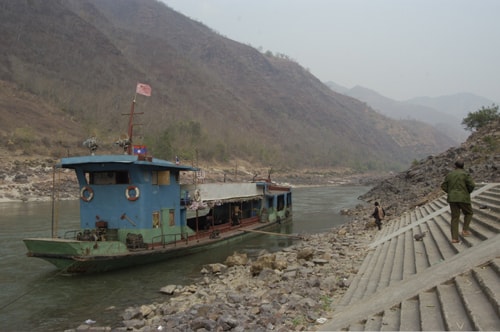 |
Many people in the lower Mekong River are miserable because of the record low water level. Photo: InternationalRiver |
"It is likely that Cambodia's Tonle Sap will shrink significantly during the rainy season, reducing its important role as a major food source for the Cambodian people through the fish that live in the lake," Mr. Ossborne said.
The Cambodian Fisheries Alliance recently released a report showing that Chinese dams on the Mekong River have “affected fish populations in the Tonle Sap Lake.” “When hydropower dams are built, people living around the lake are seriously affected because they change fish resources, leading to a continuous decline in fish populations,” the report stressed.
But according to experts, perhaps no country in the Mekong sub-region has suffered as severely as Vietnam, the world's second-largest rice exporter, with the rice granary in the Mekong Delta heavily dependent on water from this river.
Mr Cronin said the Mekong Delta, home to about 18 million Vietnamese people and contributing to half of the country’s rice production, is the region most vulnerable to rising sea levels caused by climate change. This situation is exacerbated by the Mekong River not providing enough water for agricultural production and people’s daily needs.
In fact, the Mekong Delta provinces are experiencing a historic drought and saltwater intrusion, causing saltwater to encroach 70-90 km inland, 15-20 km deeper than the average of many years, damaging hundreds of thousands of hectares of rice.
"Vietnam is facing threats from two sides as China increasingly has the ability to interfere with the flow of the Mekong River with large dams, while increasing pressure with illegal artificial island construction activities in the East Sea," Mr. Cronin commented.
Risk of instability
Mr. Cronin said that the increasingly fierce competition among countries for access to the rich resources in the Mekong region not only causes serious degradation of the natural environment, but also affects security and stability of the region and the world.
Recently, Singaporean and Cambodian media reported that Thailand is pumping a large amount of water from the Mekong River for storage, and is about to build several water barriers from Mekong River branches and build three reservoirs to store water for the country's agriculture.
Accordingly, Thailand has arranged four temporary pumping stations to pump 47 million cubic meters of water from the Mekong River into the Huai Luang River in Nong Khai province, and mobilized soldiers to dig 4,300 wells and 30 new dams. Somkiat Prajamwong, an official of the Royal Thai Irrigation Department, said that a new, larger pumping station with a capacity of 150 cubic meters per second will continue to be built to pump water from the Mekong River.
Vietnam has expressed concern about the water withdrawal plan and also asked Thailand to provide specific information on the project to divert water from Huay Luang, a tributary of the Mekong River, for agricultural use.
When China announced the release of water from its dams to help the downstream areas fight drought, irrigation experts said that Vietnamese people should not be too optimistic because the water before reaching Vietnam will be blocked mostly in Thailand, Laos, and Cambodia - countries that are also suffering from severe drought.
According to experts, with the current drought situation, rice production in the Mekong countries will decrease, causing a severe impact on the global economy. As the Mekong region produces less rice, food prices in countries that have to import rice are likely to increase, leading to the prices of many other essential commodities.
With crop failures, fishermen will have to give up their jobs, while rice farmers will likely switch to other forms of farming, such as raising saltwater shrimp on the fields where rice was grown. Experts warn that this short-term solution will destroy the arable land of many areas, causing unpredictable and long-term consequences for the environment, and even affecting the world's food security.
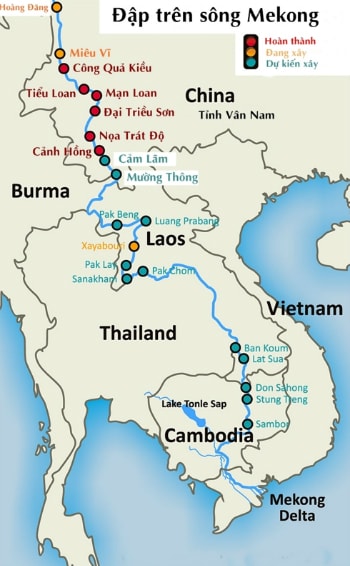 |
Hydroelectric dams have been and are about to be built on the Mekong River. Graphics: Michael Buckley |
The Mekong River Commission, an international body created in 1995 to monitor and share information on the exploitation of the river’s resources, has repeatedly protested against activities that affect the river’s flow. However, the commission lacks the necessary power to intervene, while member countries often go their own way.
Meanwhile, despite the serious consequences of China’s dam-building activities, many governments have shown little interest in speaking out against them, Cronin said. China is a huge export market for many countries’ resources and agricultural products, while Laos and Cambodia have received large amounts of Chinese infrastructure development aid in recent years, the expert pointed out.
China’s opacity in disclosing information about its dams makes the situation worse, but it could also backfire on Beijing. “China’s disregard for the interests of its neighbors is creating growing resentment among downstream countries, making it more difficult for Beijing to achieve its long-term goals in the Mekong basin and exert greater influence in the region,” Cronin stressed.
According to VNE
| RELATED NEWS |
|---|

